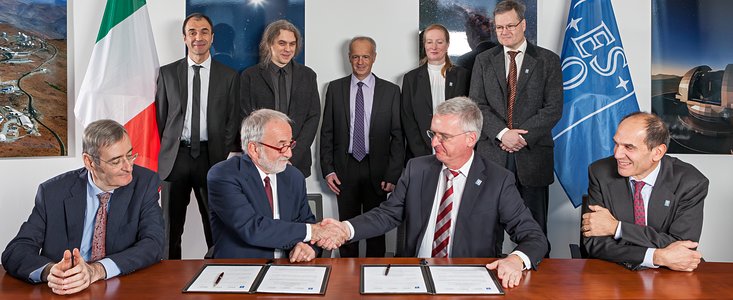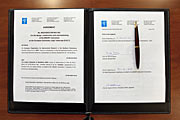Ogłoszenie
Agreement Signed for E-ELT MAORY Adaptive Optics System
10 grudnia 2015
An agreement has been signed between ESO and an international consortium [1] for the design and construction of the MAORY adaptive optics system, to be operated at the European Extremely Large Telescope (E-ELT).
The agreement was signed by Nicolò D'Amico, President of the Istituto Nazionale di Astrofisica (INAF, Italy), on behalf of the consortium, and Tim de Zeeuw, ESO Director General, at a ceremony held at ESO Headquarters in Garching bei München, Germany, on 10 December 2015. The principal investigator of MAORY, Emiliano Diolaiti (INAF), was also present.
Renato Cianfarani, Italian Consul General, and Roberto Tamai, ESO E-ELT Programme Manager, were also in attendance. Other participants included Paolo Ciliegi (INAF MAORY Project Manager), Philippe Feautrier (IPAG MAORY co-investigator), Filippo Maria Zerbi (Head of National Division for Ground Based Programmes in the Scientific Directorate of INAF), as well as Giovanni Fabrizio Bignami, Italian member of ESO Council.
MAORY, or Multi-conjugate Adaptive Optics RelaY, will enable near-infrared instruments attached to the E-ELT, such as MICADO, the first generation E-ELT camera, to benefit from laser guide star adaptive optics assisted observing.
MAORY carefully analyses the light from six laser guide stars and three natural guide stars to calculate the precise adjustments to be applied to deformable mirrors located in the light path between the object in the sky and the science instrument.
By making fast, but tiny, changes to the shapes of these mirrors, the disturbing effects of the atmosphere on astronomical sources can be cancelled out. This greatly sharpens the images received by the detector and so improves our ability to detect very small features in astronomical objects. Adaptive optics also allows astronomers to detect fainter sources, for example more distant galaxies, as the light arriving in the science camera becomes more concentrated. MAORY will hence enable the high resolution camera MICADO to achieve its ambitious science goals.
MAORY is designed to use three deformable mirrors, one of which is the massive telescope’s 2.4-metre quaternary mirror. The other deformable mirrors will be located within MAORY itself. By using more than one deformable mirror, MAORY compensates for turbulence in layers at different altitudes in the atmosphere. The net effect for the astronomer, compared to simpler adaptive optics systems, is that observations over a much wider field of view benefit from improved images.
MAORY will build on the experience of the Multi-Conjugate Adaptive Optics Demonstrator (MAD), which proved the feasibility of the technology behind MAORY on ESO’s Very Large Telescope (VLT). MAORY has also drawn on extensive earlier development work over many years, both at ESO and in the community, as well as current work on the Adaptive Optics Facility of the VLT. It will enable the E-ELT to fully exploit its position as the world's biggest eye on the sky.
Notes
[1] The MAORY consortium consists of Istituto Nazionale di Astrofisica (Italy), and Institut National des Sciences de l’Univers du Centre National de la Recherche Scientifique (France).
Linki
Kontakt
Emiliano Diolaiti
MAORY Principal Investigator
INAF
Bologna, Italy
Tel: +39 051 2095708
Email: emiliano.diolaiti@oabo.inaf.it
Philippe Feautrier
MAORY Co-Investigator
IPAG
Grenoble, France
Tel: +33 4 76 63 59 81
Email: philippe.feautrier@obs.ujf-grenoble.fr
Suzanne Ramsay
ESO MAORY Project Scientist
Garching bei München, Germany
Tel: +49 89 3200 6665
Email: sramsay@eso.org
Florian Kerber
ESO MAORY Project Manager
Garching bei München, Germany
+49 89 3200 6757
Email: fkerber@eso.org
Richard Hook
ESO Public Information Officer
Garching bei München, Germany
Tel: +49 89 3200 6655
Cell: +49 151 1537 3591
Email: rhook@eso.org
O ogłoszeniu
| Identyfikator: | ann15093 |
Our use of Cookies
We use cookies that are essential for accessing our websites and using our services. We also use cookies to analyse, measure and improve our websites’ performance, to enable content sharing via social media and to display media content hosted on third-party platforms.
ESO Cookies Policy
The European Organisation for Astronomical Research in the Southern Hemisphere (ESO) is the pre-eminent intergovernmental science and technology organisation in astronomy. It carries out an ambitious programme focused on the design, construction and operation of powerful ground-based observing facilities for astronomy.
This Cookies Policy is intended to provide clarity by outlining the cookies used on the ESO public websites, their functions, the options you have for controlling them, and the ways you can contact us for additional details.
What are cookies?
Cookies are small pieces of data stored on your device by websites you visit. They serve various purposes, such as remembering login credentials and preferences and enhance your browsing experience.
Categories of cookies we use
Essential cookies (always active): These cookies are strictly necessary for the proper functioning of our website. Without these cookies, the website cannot operate correctly, and certain services, such as logging in or accessing secure areas, may not be available; because they are essential for the website’s operation, they cannot be disabled.
Functional Cookies: These cookies enhance your browsing experience by enabling additional features and personalization, such as remembering your preferences and settings. While not strictly necessary for the website to function, they improve usability and convenience; these cookies are only placed if you provide your consent.
Analytics cookies: These cookies collect information about how visitors interact with our website, such as which pages are visited most often and how users navigate the site. This data helps us improve website performance, optimize content, and enhance the user experience; these cookies are only placed if you provide your consent. We use the following analytics cookies.
Matomo Cookies:
This website uses Matomo (formerly Piwik), an open source software which enables the statistical analysis of website visits. Matomo uses cookies (text files) which are saved on your computer and which allow us to analyze how you use our website. The website user information generated by the cookies will only be saved on the servers of our IT Department. We use this information to analyze www.eso.org visits and to prepare reports on website activities. These data will not be disclosed to third parties.
On behalf of ESO, Matomo will use this information for the purpose of evaluating your use of the website, compiling reports on website activity and providing other services relating to website activity and internet usage.
Matomo cookies settings:
Additional Third-party cookies on ESO websites: some of our pages display content from external providers, e.g. YouTube.
Such third-party services are outside of ESO control and may, at any time, change their terms of service, use of cookies, etc.
YouTube: Some videos on the ESO website are embedded from ESO’s official YouTube channel. We have enabled YouTube’s privacy-enhanced mode, meaning that no cookies are set unless the user actively clicks on the video to play it. Additionally, in this mode, YouTube does not store any personally identifiable cookie data for embedded video playbacks. For more details, please refer to YouTube’s embedding videos information page.
Cookies can also be classified based on the following elements.
Regarding the domain, there are:
- First-party cookies, set by the website you are currently visiting. They are stored by the same domain that you are browsing and are used to enhance your experience on that site;
- Third-party cookies, set by a domain other than the one you are currently visiting.
As for their duration, cookies can be:
- Browser-session cookies, which are deleted when the user closes the browser;
- Stored cookies, which stay on the user's device for a predetermined period of time.
How to manage cookies
Cookie settings: You can modify your cookie choices for the ESO webpages at any time by clicking on the link Cookie settings at the bottom of any page.
In your browser: If you wish to delete cookies or instruct your browser to delete or block cookies by default, please visit the help pages of your browser:
Please be aware that if you delete or decline cookies, certain functionalities of our website may be not be available and your browsing experience may be affected.
You can set most browsers to prevent any cookies being placed on your device, but you may then have to manually adjust some preferences every time you visit a site/page. And some services and functionalities may not work properly at all (e.g. profile logging-in, shop check out).
Updates to the ESO Cookies Policy
The ESO Cookies Policy may be subject to future updates, which will be made available on this page.
Additional information
For any queries related to cookies, please contact: pdprATesoDOTorg.
As ESO public webpages are managed by our Department of Communication, your questions will be dealt with the support of the said Department.



